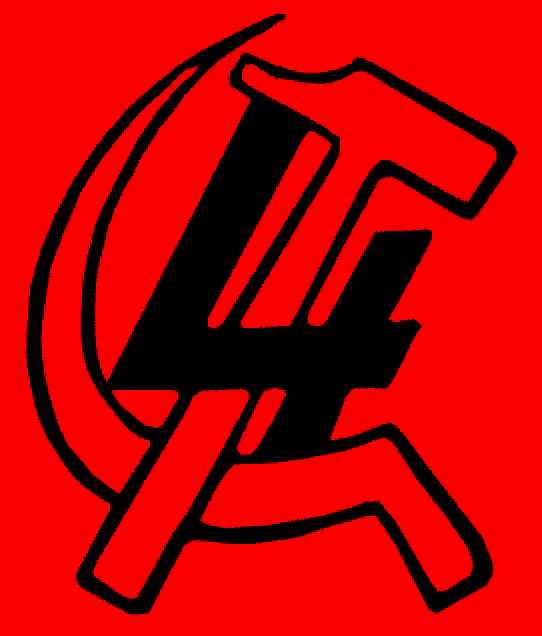
December 2008
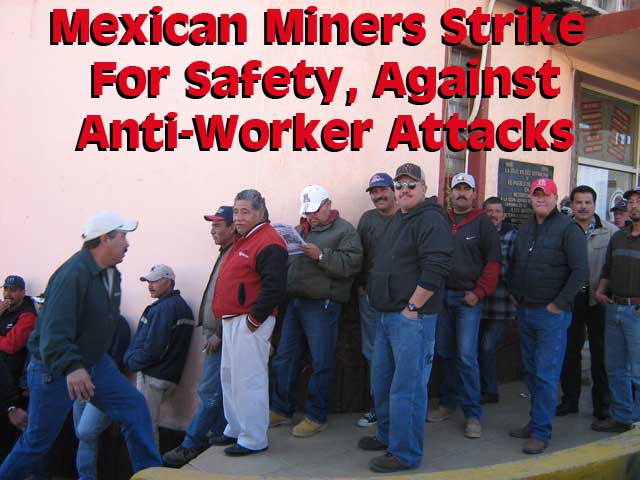
Striking miners in Cananea during December visit of SITUAM union delegation. (Photo: El Internacionalista)
- Bring Grupo México to its Knees With a Nationwide Miners’ strike!
- For a National Strike Against Calderón's Starvation Programs!
- Down with the PRI, PAN and PRD, Parties of the Bourgeoisie!
- Forge a Revolutionary Workers Party!
The following article is translated
from a supplement to El
Internacionalista published by our comrades of the Grupo
Internacionalista
in Mexico and distributed to miners in Cananea along with the
accompanying
article, “Cananea:
A Century of Internationalist Class Struggle.”
DECEMBER 15 – The strike of
copper miners in Cananea, in the northern Mexican state of Sonora, at a
zinc
plant in Sombrerete, in the state of Zacatecas, and at silver mines in
Taxco,
Guerrero, is now halfway into its fifth month. The walkout, which began
on July
30 demanding compliance with the contract and with the most elementary
job
safety standards, has met with a concerted hard-line response from the
bosses
(Industrial Minera México, belonging to billionaire
Germán Larrea’s infamous
Grupo México1)
and the
bourgeois government of Felipe Calderón, whose labor secretary
is blatantly at
the beck and call of Grupo México. One week into the strike, the
Federal
Mediation and Arbitration Board2,
declared it “nonexistent,” only to reluctantly permit it when a federal
judge
granted an injunction to the mine workers organization.
In September, the same labor tribunal
granted legal recognition to a new company union, the “Single Union of
Mine
Workers” headed by Francisco Hernández
Gámez, and ordered
a new vote to decide
who would have the contract at Grupo México’s plants. At the
beginning of
December, Germán Larrea threatened to shut the mines if the
miners didn’t
return to work. This is not the first time he has used this ploy:
during the
Cananea mine workers’ strikes of January 2003 and October 2004, he
brandished
the same threat. But this blackmail by the copper baron is all smoke
and
mirrors, particularly when you consider that Cananea alone represents
64
percent of Grupo México’s potential earnings, and its copper
deposits are
estimated to last for anywhere from 30 to 82 years of production at
current
rates (La Jornada, 4 December 2007). In other words, any
“closing” would
simply be a legal maneuver.
The truth is that the miners have
Larrea by the throat. Now what has to be done is squeeze, by launching
a
nationwide mining strike against all the affiliates of Grupo
México, and if
necessary, to extend the strike to the conglomerate’s other sectors,
like
FerroMex (rail freight), and to other companies like the steel mill
complex in
Lázaro Cárdenas, Michoacán. But in order to do
this, it will be necessary to
confront the whole corporatist control apparatus that the capitalist
state
imposes on Mexican labor relations. This is the heart of the
problem.
In the course of their attack against
the mine strike, the bosses and their government have maintained that
all
issues pertaining to safety have been resolved. It’s all lies. We all
know what
Grupo México means by “workplace safety standards”: dead
workers. This is the
company that is responsible for the murder of 65 miners at
Pasta de
Conchos, in the state of Coahuila, in February 2006. One of the Cananea
miners’
demands that the company deems “unacceptable” is for the recovery of
the
remains of the dead miners at Pasta de Conchos. It has been amply
demonstrated
that management’s actions sent the miners to the slaughter, with the
complicity
of the state and federal governments. But the bureaucracy of the
corporatist
mineworkers’ “union,” the SNTMMSRM3,
shares the blame for this “industrial homicide.”
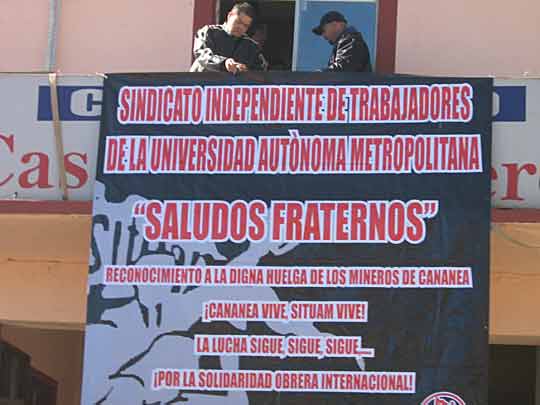 Workers
hang banner of solidarity greetings from Union of Workers of the
Metropolitan Autonomous University (SITUAM) to striking Cananea
miners, December 2007.
Workers
hang banner of solidarity greetings from Union of Workers of the
Metropolitan Autonomous University (SITUAM) to striking Cananea
miners, December 2007.
(Photo: El Internacionalista)
As it was a century ago, mining is the
most dangerous branch of industry, even though the technology exists
today to
make it substantially safer. This isn’t just true of the mines of Grupo
México,
either: capitalist mining in this country is built upon the systematic
murder
of mine workers. Putting an end to this macabre spiral of death should
not only
fall on the shoulders of the militant local 65 of the SNTMMSRM in
Cananea,
which has gone on strike nearly every year over the last decade,
despite
suffering defeat each time. The heroic miners of Cananea must not stand
alone.
The miners’ strike in Cananea, Sombrerete and Taxco should be a spark
that
ignites a proletarian counteroffensive across the country to defeat the
bosses’
attack. What’s needed is a national strike against the repressive
starvation
policies of the Felipe Calderón government.
This, in turn, requires a struggle for
complete independence of the working class from the bourgeoisie, its
parties,
its strong men, and its state. It’s not enough to just struggle against
the
federal government in the hands of the PAN (Calderón’s National
Action Party).
The workers must also tear off the corporatist straightjacket that
binds them
to the capitalist state and its former state party, the PRI
(Institutional
Revolutionary Party), and break as well from the popular front around
the PRD
(Party of the Democratic Revolution) of Andrés Manuel
López Obrador. With this
revolutionary perspective the miners’ present struggle, like the
historic
strike in Cananea one hundred years ago4,
could presage the beginning of a revolutionary struggle. The next
Mexican revolution
must be a workers socialist revolution, and it requires above
all else a
struggle to forge a revolutionary leadership.
Not long after the current strike
began, a miner from Taxco commented that for the mine bosses, the death
of one
worker costs less than purchasing the necessary safety equipment: “If
one of us
gets killed on the job, the insurance policy pays. On the other hand,
if a
machine is damaged, the company is liable” (La Jornada Guerrero,
10
August 2007). In Taxco, red and black flags (the traditional sign in
Mexico
denoting a struck enterprise) have been placed at three silver mines.
Miners
say that the prevailing conditions there are the same as they were in
Pasta de
Conchos in the fateful pre-dawn hours of 19 February 2006. The
electrical
system is deficient, with cables tangled around the water lines, fuse
boxes
without insulating covers, machinery without emergency brakes, and rock
slides.
Forced to make do with obsolete, run-down equipment, the miners have
suffered
an escalating rate of accidents in recent years.
The situation is no different at the
zinc plant at Sombrerete. A report published last June stated that
three miners
had been killed there. Besides the terrible condition of the electrical
system,
the buildup of silica dust and the lack of air-filtering systems is a
constant
threat to the health of the miners. The same goes for the Cananea mine,
where
dust is caked on every surface. The extraction of copper from this
open-pit
mine requires the successive crushing of the mountain’s rock into
ever-finer
particles. The accumulated dust produces a whole range of respiratory
disorders, including silicosis, the miner’s scourge, and can cause lung
cancer.
Today, the technology exists that could
allow the mines operate at high standards of safety. All it would
require is
investing in the physical plant and its maintenance. Furthermore, the
miners
could be given personal safety gear, such as artificial respirators,
and
plastic barriers to isolate poisonous gases, etc. Many mines in the
United
States and Europe rely on powerful suction fans with filters to remove
the
deadly silica dust. However, implementing such basic safety precautions
is
contrary to the thirst for profits that drives production under
capitalism. For
the mining firms, whether state-owned or private, it is more profitable
to keep
the unhealthy conditions that ensure death to the workers.
It does not have to be this way: the
workers should force the implementation of the necessary measures to
save their
lives. Union safety committees must be formed, empowered to
stop
production when health or lives are at risk. It is essential that
such
committees be made up only of workers, because the decisions to protect
the
miners’ lives must not be influenced by financial considerations. The
ubiquitous “tripartite” worker/management/government commissions only
exist to
prevent the workers from acting. Workers safety committees must have
the
physical means (master switches and circuit breakers) and coverage,
with
delegates in every work area and department, so that decisions can
carried out
on the spot. In fact, in Cananea, a North American labor journalist
reported:
“‘We know what’s safe and
what’s not,’ one miner commented, ‘but they never want us to spend time
fixing
problems – just get the production out. If we tried to stop the line
for safety
problems, we would lose our jobs.’ Many safety lines running alongside
the
conveyers, which should stop the speeding belt in case of an accident,
have
been cut so they can’t be pulled, or are simply absent.”
–David Bacon, “The Killing
Dust,” Truthout, 11 October
Bacon points out that in various areas
of the facility, air filters haven’t been turned back on since the 1999
strike;
water tanks, essential for dust abatement, have huge holes rusted out:
“So for the past eight
years, dust that should have been sucked up by the collectors has ended
up
instead in the miners’ lungs.... But there are other dangers. Many
machines
have no guards, making it easy to lose fingers or worse. Electrical
panels have
no covers. Holes are open in the floor with no guardrails. Catwalks
many
stories above the floor are slippery with dust and often grease, and
are
crisscrossed by cables and hoses. Not long ago, one worker tripped and
fell
five stories to his death onto a water pump below.”
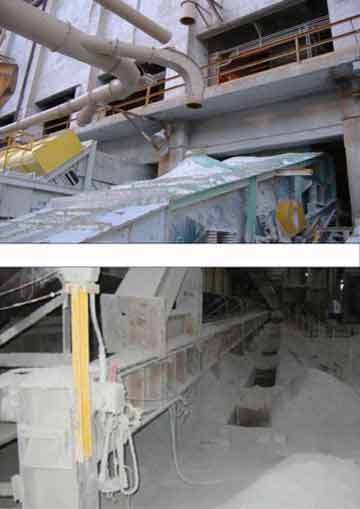 Report by
international commission organized by Maquiladora Health & Safety
Support Network documented how dust collectors have been disconnected
by the company (top), leading to huge accumulations of deadly silica
dust as well as dangerous holes in the floor. (Photo: MHSS)
Report by
international commission organized by Maquiladora Health & Safety
Support Network documented how dust collectors have been disconnected
by the company (top), leading to huge accumulations of deadly silica
dust as well as dangerous holes in the floor. (Photo: MHSS)
It is truly an infernal image. A
commission of eight doctors and specialists in industrial safety who
inspected
the facility at Cananea at the beginning of October produced a detailed
report
in which they enumerate the broad variety of violations to the most
basic
safety rules. The findings are enough to make your hair stand on end:
“The conditions observed
inside the mine and processing plants, and the work practices reported
by the
interviewed workers, paint a clear picture of a workplace being
‘deliberately run into the ground.’ A serious lack of
preventive
maintenance, failure to repair equipment and correct visible safety
hazards,
and a conspicuous lack of basic housekeeping has created a work site
[where]
workers have been exposed to high levels of toxic dusts and acid mists,
operate
malfunctioning and poorly maintained equipment, and work in simply
dangerous
surroundings.
“The deliberate dismantling
of dust collectors in the Concentrator area processing plants by Grupo
Mexico
approximately two years ago means that workers in these areas have been
subjected to high concentrations of dust containing 23% quartz silica,
with 51%
of sampled dust in the respirable particle size range, protected only
by completely
inadequate personal respirators. Occupational exposures to silica can
lead to
debilitating, fatal respiratory diseases including silicosis and lung
cancer.”
[emphasis in original]
–Workplace Health and
Safety Survey And Medical Screening of Miners At Grupo Mexico’s Copper
Mine
Cananea, Sonora, Mexico, dated 12 November, available online at http://mhssn.igc.org/CananeaOHSReport.pdf.
The report is chock full of
details of the terrible conditions that prevail in the mines and the
surrounding factories. The workers not only face the constant risk of
inhaling
poison dust, but also chemical vapors, electric shocks, falls from
great
heights, etc.
Break the
Shackles of Corporatism! Forge a Revolutionary Workers
Party!
Clearly, the miners’ strike needs no
further justification. Even so, it has been attacked on many fronts.
The
powerful Grupo México, a conglomerate that benefited from the
privatizations
undertaken by Mexican presidents Carlos Salinas de Gortari (1988-1994)
and
Ernesto Zedillo (1994-2000), and subsequently has been protected by the
PAN
governments of Vicente Fox and Felipe Calderón, has used the
labor boards to
its advantage, besides resorting to open gangsterism (which left one
miner dead
in Cananea last June) and the formation of a company union. But at
bottom the
current unsafe conditions in Mexico’s mines are the result, at least
quantitatively, of the privatization of the mining industry that was
carried
out at the end of the ’80s with the connivance of the miners’
“union,” a
corporatist formation (known in Mexico as charro unions5)
integrated into the state apparatus through its incorporation into the
PRI.
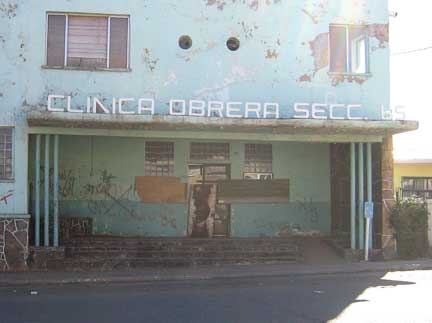 Workers
clinic shuttered by Grupo Mexico bosses after defeat of 1999 miners
strike.
Workers
clinic shuttered by Grupo Mexico bosses after defeat of 1999 miners
strike.
(Photo: El Internacionalista)
The former head of the SNTMMSRM,
Napoleón Gómez Sada, father of the current president,
Napoleón Gómez Urrutia,
always functioned as a government man, the rightful heir to the founder
of the
corporatized mining union, Jesús Carrasco, in the 1940s. Thus,
for example, one
of the principle demands of the current miners’ strike in Cananea is
for the
reopening of the workers’ clinic, closed by the bosses after the defeat
of the
1999 strike, when the national miners’ “union” not only failed to
support the
Cananea strikers, but openly took the side of the government and the
bosses
(see “Cananea: A Century of Internationalist Class Struggle”).
The corporatist “unions,” fully
integrated into the capitalist state, have chained the workers to their
exploiters. These organizations’ primary function has been to suppress
the
workers’ expressions of discontent and to impede the formation of
genuine
workers’ organizations. The “charro” union leaders and their
thugs
constantly break strikes, assaulting and even murdering hundreds of
dissident
workers. As we highlighted in our article “Capitalist Murder in Pasta
de
Conchos” (El Internacionalista/Edición México no.
2, August 2006), the
SNTMMSRM under Gómez Sada played a central role in knifing
workers’ struggles
against privatization and massive layoffs, or if he could not prevent
these
struggles from breaking out, in isolating them. Today his son has
fallen out of
favor of the PAN governments, despite having been a favorite of the
fascistic
Carlos Abascal, Fox’s first labor secretary.
What is happening is that the
corporatist system that characterized the one-party regime, the
PRI-government,
that ruled Mexico for seven decades is decaying, but has not yet
disappeared.
When the mines were state-owned and the PRI controlled the governmental
apparatus at every level, there was a circulation of government
functionaries
such that today’s “union” chief could be a government official or PRI
parliamentary deputy or senator tomorrow, and later the head of the
company.
Since the privatization of the state enterprises that began in the
’80s, and
accelerated with the PRI’s defeat in the 2000 presidential elections,
cracks
have begun to appear in what was once a monolithic edifice of
capitalist state
control. However, the corporatist regime came into existence for
reasons that
have not themselves disappeared: the weak Mexican bourgeoisie
confronts, on one
hand, a proletariat with enormous potential power, while on the other,
it is
subject to the powerful influences of Yankee imperialism.
Thus, the corporatist “union”
apparatus, though weakened, has persisted in functioning as the
bourgeoisie’s
labor police. Those elements of the PAN government closest to the
leading
capitalists would like to do away with these legacies of the PRI regime
that
they now consider unnecessary, while other capitalist sectors see the
need to
maintain a “union” security buffer. Thus while Secretary of Labor
Francisco
Xavier Salazar Sáenz took aim at Gómez Urrutia in 2006,
the head of Mexico’s
powerful interior ministry (Gobernación) Carlos Abascal
continued to recognize
him as head of the union. And in April of 2007, in accordance with a
federal
court ruling that discovered irregularities and falsifications in his
dismissal
as president of the SNTMMSRM, the Labor Department reinstated
Gómez Urrutia and
withdrew its endorsement of his replacement, Elías Moralez
Hernández.
Nevertheless, there are still a series of court cases pending against
the
miners’ leader, and he has had to take refuge in Canada. We demand that
all the
charges against leaders of ostensible labor organizations be dropped,
since they
serve as an attack by the capitalist state against the mine workers.
We of the Grupo Internacionalista have
opposed all capitalist government intervention in the affairs of the
workers
movement. We supported the mine workers’ strike in March of 2006, which
was
called off after the legal deadline of 72 hours in compliance with the
judicial
ruling declaring it non-existent, and we called for its extension to
the whole
working class in a nationwide strike against government repression. We
came out
for freeing all the imprisoned workers, and for all charges against
them to be
dropped, at the same time as we continue to fight for the independence
of the
unions from state control. Thus, we wrote:
“What is needed at this
moment is to overcome the state framework and launch a national
strike
against the murderous government, to fight for victory to
the
teachers strike in Oaxaca and to the miners’ strikes; for total
independence of the unions from the bourgeoisie, breaking the
shackles of
corporatist pseudo-unionism and rejecting the government’s attack on
the miners
and metal workers; for freedom and dropping of all charges against all
the
workers, peasants and teachers arrested as victims of the ruling class’
repressive onslaught.”
–El Internacionalista/Edición
México No. 2, August 2006
The fact that we oppose bourgeois
repression does not change the bourgeois character of the corporatist
aparatus
one bit, nor does it postpone the struggle to replace the corporatist
unions
with genuine workers’ organizations. To make a truce with the charro
bureaucracy condemns the struggle against anti-working class
persecution to
failure, because in the final analysis these cogs of the capitalist
state
machinery take their orders from their bourgeois masters.
It is precisely in the struggle against
anti-union repression that workers’ committees can be formed that break
with
the corporatist structure and champion complete independence from the
bourgeoisie. In this struggle, historically militant sectors which the
corporatist charro “unions” have not been able to completely
regiment,
can play a key role, provided that they escape the corporatist
manacles. We
have documented how sections 65 (Cananea), 271 (Lázaro
Cárdenas), 288
(Monclova), 201 (Sombrerete) and 17 (Taxco) of the SNTMMSRM have
repeatedly
been forced to fight against their own “union” which has supported the
company
against its own members. The same goes for Section 22 of the teachers
of Oaxaca
and other sections affiliated with the National Coordinating Committee
of Education
Workers (CNTE) vis-à-vis the corporatist National Union of
Education Workers
(SNTE), whose gunmen have murdered over 150 of their members. From the
so-called democratic insurgency in the electrical workers organizations
in the
‘70s, the refusal to break out of the shell of the corporatist “unions”
has
condemned their struggles to defeat.
We insist that the workers must
clean their own house. If the capitalist state persecutes a
Napoleón Gómez
Urrutia for corruption or some other accusation, whether the charges
are true
or not, it is because the ruling class wants to exploit the workers
even more
harshly. Today, in the epoch of “globalization” following the
destruction of
the Soviet Union, along with its bureaucratic Stalinist leadership,
even the charro
corporatist apparatuses that provided a few crumbs for the workers, as
well as
programs like Social Security, represent an unprofitable expense for
the bosses
eager to extract the maximum surplus value from “their” wage slaves.
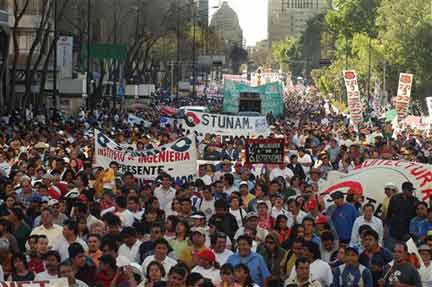 March in
solidarity with miners, Mexico City, 6 March 2006. Today a national
strike is urgently needed to support striking miners. (Photo:
AP)
March in
solidarity with miners, Mexico City, 6 March 2006. Today a national
strike is urgently needed to support striking miners. (Photo:
AP)
To win this struggle – which is nothing
less than the miners’ fight for their very lives – requires carrying
out a
sharp class struggle. The miners will not gain a victory in the labor
tribunals
or arbitration boards. They need to mobilize their social power. This
is what
they are doing now, and they have halted production in three important
mines,
resulting in a 60 percent reduction in copper production. Their
struggle must
not remain isolated: it must be part of a powerful proletarian answer
to the
capitalist assault that has raised the price of tortillas 80 percent in
the
last year alongside drastic increases in the prices of almost all
staple goods
culminating in the gasolinazo, the “gasoline shock” scheduled
for
January. This goes along with the elimination of tariffs on grain
imports,
which will result in the destruction of what remains of Mexican
agriculture. To
impose this anti-worker, anti-peasant program, the rapacious national
bourgeoisie is militarizing the country to suffocate outbreaks of
social
unrest.
In this panorama, the semi-corporatist
leaders of the National Union of Workers (UNT) and the “independent”
unionists
of the Mexican Labor Front (FSM) headed by the powerful electrical
workers’
union (SME) have been notable for their lack of solidarity with the
embattled miners.
We call on the “independent” unions in particular to call a national
workers
mobilization in defense of the strikers of Cananea, Sombrerete and
Taxco and to
provide them with the necessary economic support to keep up their
movement. The
bosses have various ways of controlling working-class discontent. Be it
through
the corporatist regimentation of labor, or through the subordination of
workers’ struggles to the agenda of a popular front headed by a
bourgeois party
like Andrés Manuel López Obrador’s PRD, or through the
formation of company
unions that sell sweetheart contracts in the style of the PAN, the
bourgeoisie
tries to keep all eruptions of working-class anger under their control.
The key to victory in this struggle is
for the workers to refuse to play by the rules of the game dictated by
the
bosses, and to politically break with the bourgeoisie. Despite
the PRD’s
populist rhetoric, it was the prosecutor from the PRD government of the
Federal
District (Mexico City) who ordered the arrest of Gómez Urrutia’s
subordinate,
Gregorio Pérez Romo, in 2006. The PAN, PRI and PRD, the three
main bosses’
parties, unite their forces to better crush the struggles of the
workers (like
they did in Lázaro Cárdenas, Michoacán, Atenco and
Oaxaca last year, and as they
are doing today against the teachers college students of Ayotzinapa in
Guerrero
state). For this reason, the working class needs its own political
vehicle, its
own party, to wage a genuinely revolutionary struggle, which is
essential to
winning the current strikes and social struggles. Raising up once more
the
banner of the Bolsheviks Lenin and Trotsky, the Grupo
Internacionalista,
section of the League for the Fourth International, fights to forge the
indispensible party of the workers’ vanguard. ■
1 Grupo México is the owner of the Pasta de Conchos coal mine responsible for the murder of 65 miners who were buried alive due to criminally negligent safety conditions in early 2006 (see below).
2 Mexico's Junta Federal de Conciliación y Arbitraje (JFCyA) is derived from the 1931 Federal Labor Law (LFT), modeled on Mussolini's corporatist institutions in fascist Italy.
3 Sindicato de Trabajadores Mineros, Metalúrgicos y Similares de la República Mexicana.
4 See the accompanying article, “Cananea: A Century of Internationalist Class Struggle.”
5 Charro
= cowboy. At the beginning of the Cold War, in 1946-48, the Mexican
government
completed the state takeover of the unions, expelling the “reds” from
union
leadership positions (jailing many for years), seizing union offices at
gunpoint and firing hundreds of union militants. Henceforth, union
leaders were
directly appointed by the government. The emblematic figure for this
corporatist takeover was Jesús de León, who was installed
at the head of the
railroad workers union and who liked to dress up in Mexican cowboy (charro) outfits with big sombreros
and silver decorations. Thereafter corporatist labor organizations were
known
as “charro” unions.
See
also: Mexico:
Cananea Must Not Stand Alone! (1 February 2008)
New
York Picket Protests Repression Against Mexican Miners (11
January 2008)
Cananea: A Century of Internationalist
Class Struggle (December 2008)
To contact the Internationalist Group and the League for the Fourth International, send e-mail to: internationalistgroup@msn.com